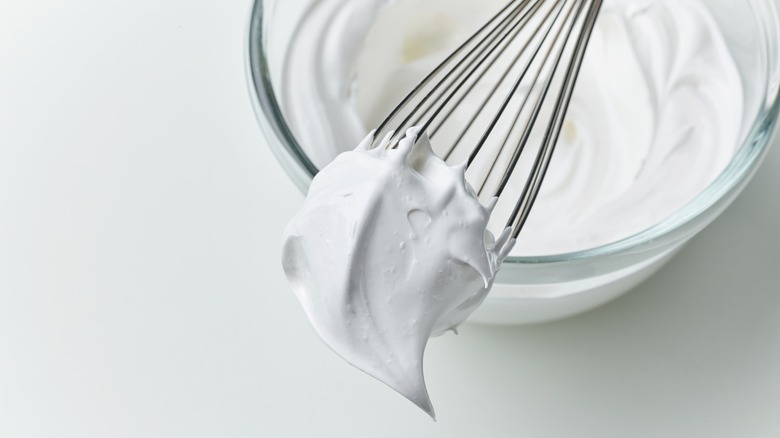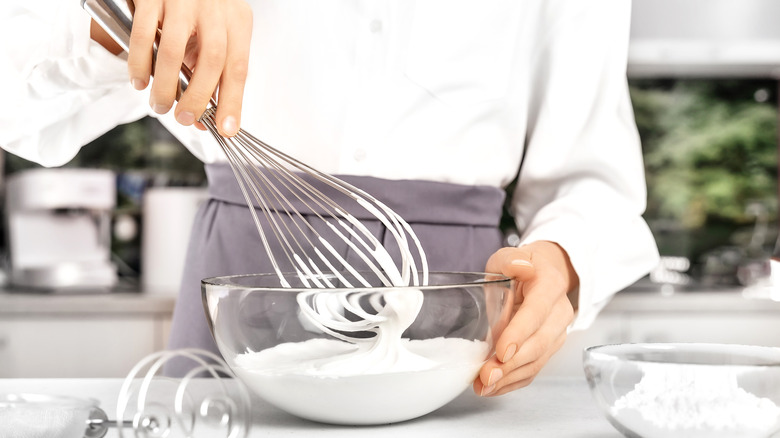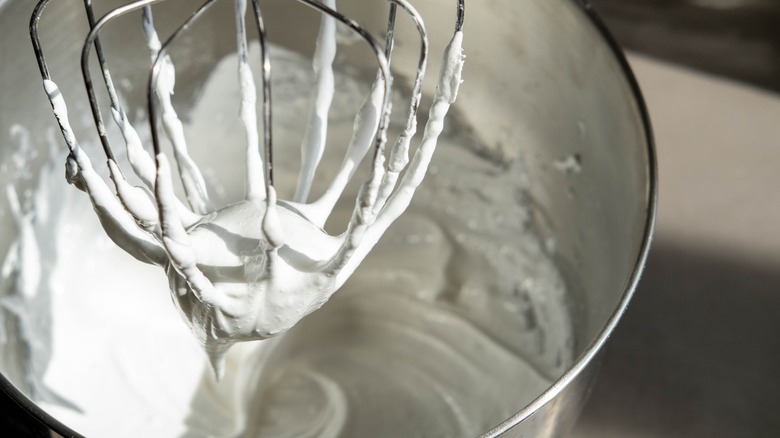Why Temperature Is A Crucial Factor When Making Whipped Cream
Nothing beats fresh whipped cream. Sure, spraying it from a can straight into your mouth is a blast, but whipping it yourself gives you a better product overall. Homemade whipped cream is thicker and creamier than the canned variety, which tends to melt into a flat puddle only a few minutes after spraying it. Canned whipped cream also contains a heap of artificial additives, and it tends to take on a metallic taste over time — a poor pairing for any dessert. Homemade whipped cream is also cheaper than its canned counterpart, giving it a leg up in almost every regard.
Of course, whipping cream yourself does take some extra time and effort, and if you don't do things properly, you can wind up with a mess. People have been whipping cream for centuries, but the challenge of achieving the perfect texture remains an obstacle for many of us. If you've been struggling to get perfect cloudy peaks when you make whipped cream, the problem may be simpler than you think. You could be doing the process correctly, just at the wrong temperature: It has to be below 50 degrees Fahrenheit. For fluffy whipped cream that holds its form, you need to literally chill out.
Whipped cream deflates at warm temperatures
To understand how temperature affects whipped cream, you need to know some kitchen chemistry. Cream is an example of a colloid — a mixture in which insoluble molecules are evenly distributed throughout another substance. In the case of cream, you have microscopic particles of fat suspended in a liquid (dairy products also contain proteins, sugars, vitamins, and minerals). In the U.S., heavy whipping cream must contain a minimum of 36% fat, according to the FDA. That may sound like a lot, but a high percentage of fat ensures that the whipped cream develops stiff peaks that hold their shape well.
When you whip cream, two crucial processes take place. Firstly, you force air into the cream, forming tiny bubbles. Secondly, the molecules of fat are typically clustered in tiny globules, but the force of whisking breaks these globules apart, destabilizing the fat. We all know that oil (fat) and water don't mix, so the fat molecules cannot bind to the water molecules in cream. Instead, the fat clusters around the air bubbles that are being introduced by whisking. This causes the air to stay trapped within the cream, steadily increasing its volume until you get a stable, fluffy whipped cream. However, this process can only happen at temperatures of 50 degrees Fahrenheit or below. If it's warmer than that, the fat will melt, and it won't be able to trap any air.
For perfect whipped cream, use a freezer
Whipping cream at temperatures over 50 degrees Fahrenheit will yield a very different, much less enjoyable result. The folks at America's Test Kitchen proved this with an experiment in which they made three batches of whipped cream. For the first, they used cream straight from the fridge, at 40 degrees Fahrenheit. For the second, they let the cream sit out for one hour, reaching 57 degrees Fahrenheit. For the final batch, they let the cream reach room temperature, 72 degrees Fahrenheit.
When whipped, the cream at 40 degrees Fahrenheit more than doubled in volume, reaching 2¼ cups, while the cream at 57 degrees Fahrenheit got to 2 cups, and the room temperature cream reached just 1¾ cups. It also took twice as long to whip the warm cream into peaks as it took to whip the cold cream.
Cold cream also yields a smoother product, as America's Test Kitchen noted that the whipped cream made with room temperature cream turned out grainy. Using cream fresh from the refrigerator is key here, but there's another step you can take to ensure your whipped cream achieves the right form. Try freezing the bowl and whisk for whipping cream, as a warm bowl and whisk can raise the temperature too quickly. This takes just a bit of pre-planning, but the results are undeniably worth it.


